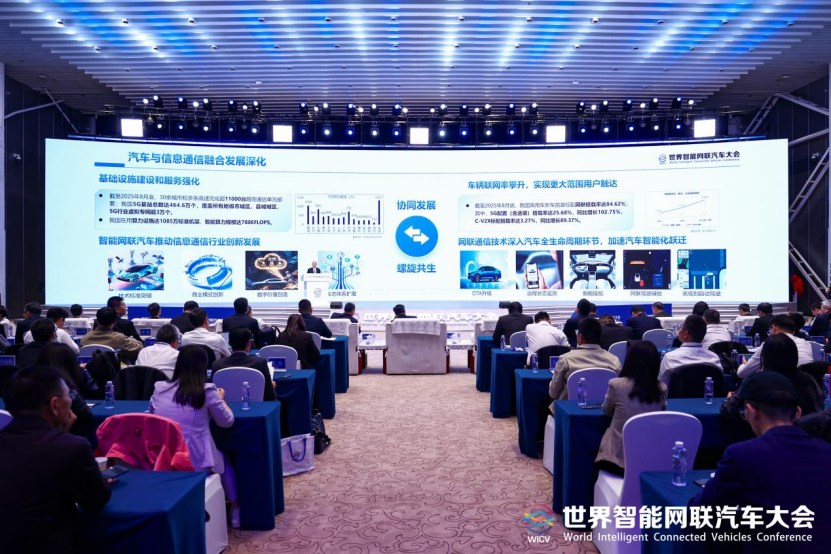Result Release: Network Technology Roadmap for Intelligent Connected Vehicles (2025-2030)
Date:2025-10-22 18:52
Typeface【 Default large Extra large 】
Currently, the integrated development of the automotive and information and communications technology(ICT)industries continues to deepen, with connected vehicles being applied to more diversified scenarios. Intelligence and connectivity have become a key focus for the upgradingof the global automotive industry. With the rapid growth of the industry, the collaborativeand mutually reinforcing relationship between connected communication technologies and intelligent connectedvehicles(ICVs)has become increasingly prominent. On the one hand, the penetrationrate of vehicle connectivity has significantly increased. Connected communication technologies are being deeply integrated throughout the vehicle lifecycle, accelerating the leap toward vehicle intelligence. On the other hand, vehicles are transforming into new mobile intelligent terminals that integrate communication, computing and control, driving the evolution, innovation and value creation of connected communication technologies, and injecting strong momentum into the development of the communication industry.
Under the guidance of the IMT-2020 (5G) Promotion Group C-V2X Working Group, the National Engineering Research Center of Mobile Communications and V2X, the China Institute of Communications, the China Society of Automotive Engineers (China-SAE), and the China Communications Standards Association, enterprises from the ICT, automotive, and safety sectors conducted in-depth research and jointly formulated the Network Technology Roadmap for Intelligent Connected Vehicles (2025-2030)(hereinafter referred to as the Roadmap). The Roadmapwas officially released at the Closing Ceremony of the 2025 World Intelligent Connected Vehicles Conference(WICV 2025)on October 18, 2025.


At the Closing Ceremony, Wei Ran, Chief Engineer of China Academy of Information and Communications Technology (CAICT), released and explained the Roadmap. He noted that ICVsput forward comprehensive requirements on the ICTindustry, including “long-term availability, stable and reliable transmission, multi-scenario adaptability and high-level security protection”. Meeting these demands requires a systematic integration of multiple communication networks, computing infrastructure and cybersecurity technologies to build a three-dimensional network system characterized by “ubiquitous access, capability coordination and trusted security”. This network system is designed to provide stable, reliable connectivity and collaborative computing capabilities for ICVs that feature broad coverage, multi-level, and on-demand services, thereby supporting the high-quality development of ICVs.
Regarding connectivity characterized by ubiquitous access and coordinated service, the key measures are: Firstly, increase the deployment of advanced communication technologies in vehicles and strengthen onboard connectivity capabilities. Secondly, expand network coverage across driving environments by achieving seamless “sky-ground” connectivity through the integration of terrestrial and satellite communications; and complement long-range cellular coverage with short-range direct vehicle-to-vehicle (V2V) or vehicle-to-infrastructure(V2I) connections to ensure stable and reliableconnectivity. Thirdly, enhance network performance based on network characteristics and specific application requirements, enabling differentiated network services and ensuring efficient, reliable data transmission.
In terms of computing infrastructure, a hierarchical “device-edge-cloud” deployment with a collaborative computing systemis needed. This willcomprehensively enhance the service capabilities of the infrastructure in areas such as device reliability, intelligent computing capability matching, and long-term operational sustainability. In addition, it is essential to strengthen the deep integration of computing resources with network transmission capabilities, providing vehicles with on-demand, precisely matched computing services.
With regard to security protection, to address complex external threats, it is necessary to build an in-depth defense system covering the entire “device-network-cloud” chain. This involves strengthening network security protection and situational awareness capabilities, establishing trusted identities, and relying on cryptographic technologies, ensuring the confidentiality, integrity, and non-repudiation of core data during transmission and storage. This approach cansystematically enhance the overall security level.
Looking into the future, we will be guided by “intelligence and connectivity” and adhere to the principles of cross-sector collaboration and integrated development. We will advance the R&D of integratedtechnologiesand expand application scenarios, so as to promote the deep transformation of automotive products, drive innovation and upgrading in ICT, and build a strong brand image for China’s ICVs.
Previous article
Next article